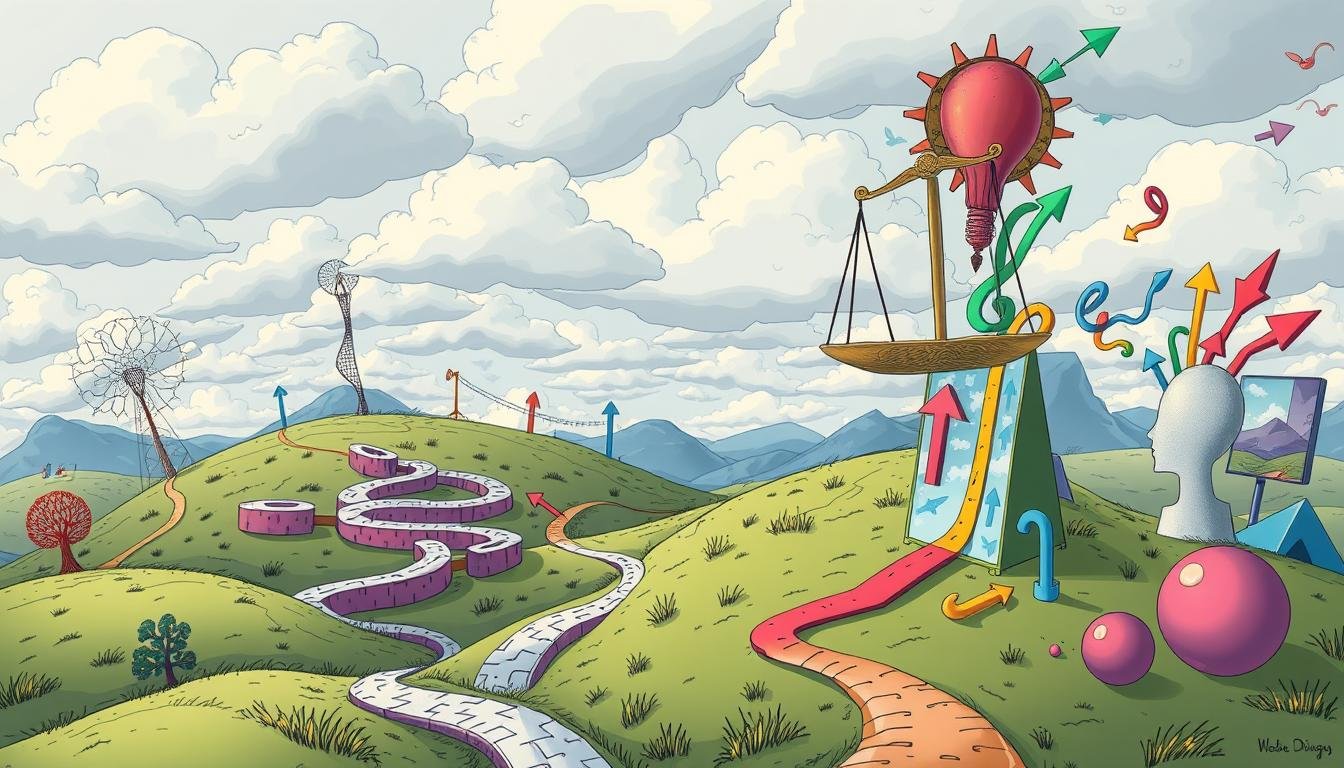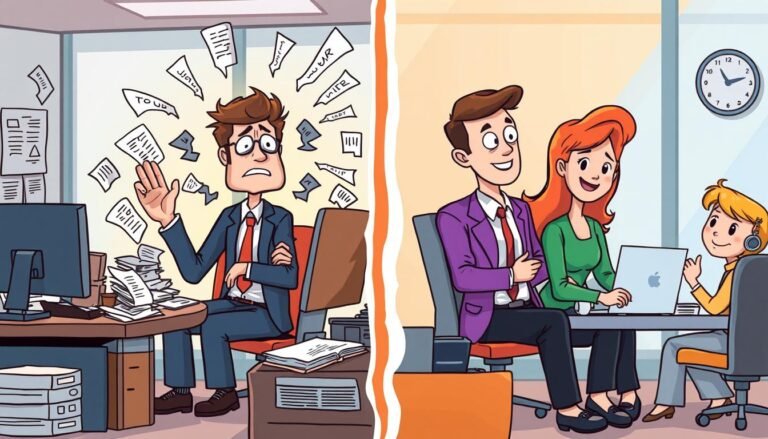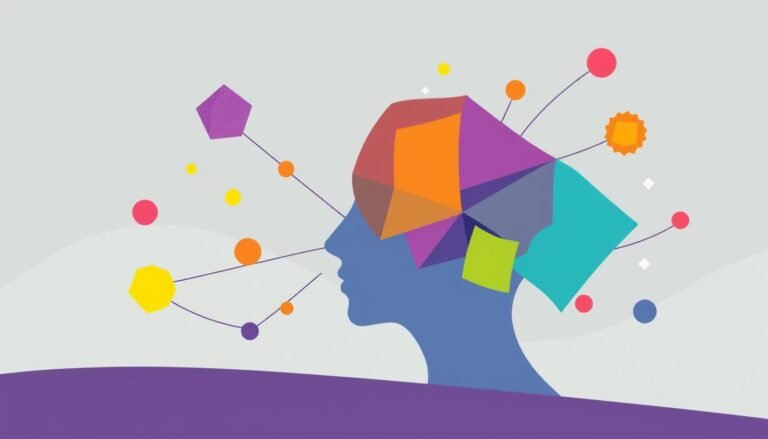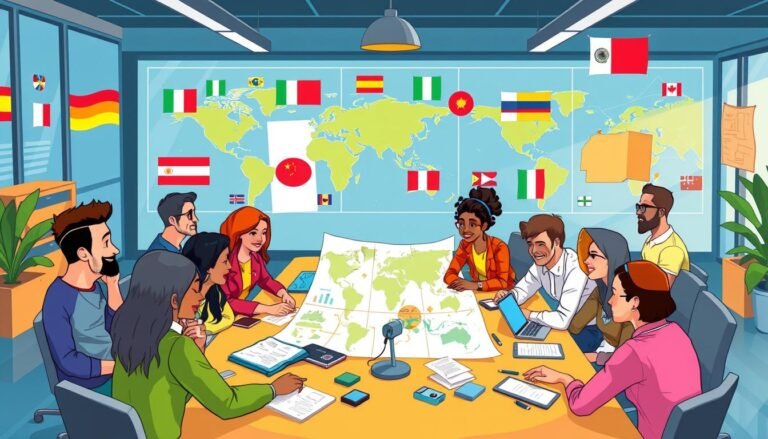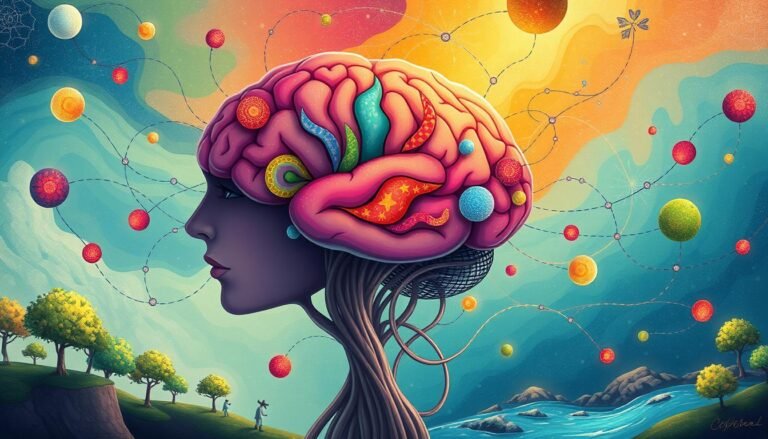Cognitive Biases in Decision Making
Our brains are amazing, but they’re not perfect. We often use mental shortcuts, or heuristics, to make quick choices. While these shortcuts can be helpful, they can also lead to errors in judgment. This is where cognitive biases come into play.
Cognitive biases are systematic errors in thinking that affect our decisions and judgments. They’re like invisible forces shaping our thoughts without us even realizing it. These biases can impact everything from our social behavior to our financial choices.
Research shows that cognitive biases can have a big impact on innovation and creativity. They can limit our ability to think outside the box and come up with new ideas. In fact, studies suggest that biases can affect various stages of innovation, from research to prototype building.
The good news is that we can learn to recognize and overcome these biases. Training to understand cognitive biases has been shown to decrease their effects by up to 29%. By being aware of our own thought processes, we can make better decisions and avoid common pitfalls of bounded rationality.
Key Takeaways
- Cognitive biases are systematic errors in thinking that affect our decisions.
- Mental shortcuts (heuristics) can lead to decision-making errors.
- Biases impact various fields, including business, healthcare, and finance.
- Understanding biases can improve innovation and creativity.
- Training can help reduce the effects of cognitive biases.
Understanding the Nature of Cognitive Biases
Cognitive biases shape our decisions in ways we often don’t see. These mental shortcuts can lead to biases in how we process information and feel. They affect how we see and interact with the world.
Definition and Core Concepts
Cognitive biases are patterns of judgment that deviate from what’s rational. They help us make quick decisions in threatening situations. Information processing biases are errors that can be fixed with new data. Emotional biases, based on feelings and attitudes, are harder to change.
Evolution of Bias Research
Since 1972, research on cognitive biases has grown a lot. Tversky and Kahneman’s work started it all. Now, we know many biases affect decision-making in different fields.
For example, confirmation bias makes us look for info that backs our beliefs. The availability heuristic makes us rely on easy-to-get info for decisions.
The Role of Heuristics
Heuristics are mental shortcuts for quick decisions. While helpful, they can also cause biases. The anchoring bias, for instance, makes us overvalue the first info we get.
Knowing these heuristics helps us spot and avoid biases in our choices.
| Bias Type | Description | Impact on Decision Making |
|---|---|---|
| Confirmation Bias | Seeking information that confirms existing beliefs | Can lead to poor investment decisions |
| Anchoring Bias | Relying too heavily on first piece of information | Affects negotiations and pricing decisions |
| Availability Heuristic | Relying on readily available information | Can impact crisis management decisions |
The Science Behind Mental Shortcuts
Mental shortcuts, or heuristics, are key in our decision-making. Cognitive psychology shows our brains use these shortcuts to make fast choices with little info. This field combines insights from decision theory and behavioral economics to explain irrational choices.
Kahneman and Tversky’s work in the 1970s started understanding mental shortcuts’ impact. Their research in behavioral economics showed we often use these shortcuts, even when they lead to wrong judgments.
There are many types of heuristics that shape our decisions:
- Recognition heuristic: We choose familiar options
- Availability heuristic: We judge likelihood by what we easily recall
- Representativeness heuristic: We categorize based on past experiences
- Anchoring and adjustment heuristic: We start with initial info and adjust
While shortcuts are efficient, they can also cause biases. For example, the affect heuristic shows how strong emotions can ignore careful thinking. Knowing these mental processes helps us understand why people make irrational choices in everyday life and business.
“The human brain can process 11 million bits of information per second, while the conscious mind can only manage around 40 to 50 pieces of information each second.”
This fact shows why our brains use mental shortcuts. By studying these processes, researchers in cognitive psychology and decision theory keep finding valuable insights into human behavior and decision-making.
Cognitive Biases in Decision Making
Our minds are complex and often take shortcuts to process information quickly. These shortcuts, known as cognitive biases, can greatly affect our decision-making. Let’s look at how these biases shape our choices and impact our critical thinking.
Information Processing Biases
Confirmation bias is a common trap we fall into. We seek out information that supports our beliefs, ignoring opposing data. This can lead to poor choices based on incomplete or biased information.
The availability heuristic also influences us. We judge the likelihood of events based on how easily we can recall similar instances. This can make us overestimate the probability of dramatic or recent events, skewing our risk assessment.
Emotional Decision-Making Biases
Emotions play a big role in our decision-making. The anchoring bias, for example, makes us rely heavily on the first piece of information we receive. This can lead to decisions that are not fully informed or rational.
Impact on Critical Thinking
These biases can severely impact our ability to think critically. They distort our perception, memory, and logical reasoning, often leading to suboptimal decisions. Understanding these biases is the first step in mitigating their effects on our decision-making process.
| Cognitive Bias | Prevalence | Impact |
|---|---|---|
| Anchoring Bias | 89% | Influences all subsequent information processing |
| Confirmation Bias | 74% | Leads to ignoring conflicting data |
| Availability Heuristic | 82% | Overestimates likelihood of recent or vivid events |
By recognizing these biases, we can work towards making more balanced and informed decisions in our personal and professional lives.
Common Decision-Making Biases in Business
In business, our minds often make quick choices that aren’t always the best. These mental shortcuts can lead to poor decisions. It’s important to understand these biases to make better choices in the workplace.
Confirmation Bias in Leadership
Leaders often look for information that confirms what they already believe. This can lead to bad decisions and missed chances. To avoid this, leaders should seek out different views and encourage open discussion.
Anchoring in Negotiations
Anchoring bias affects business talks. People often stick to the first offer, which can change the deal’s outcome. To beat this, negotiators should be well-prepared, have clear goals, and be ready to walk away if needed.
Status Quo Bias in Organizations
Companies often stick to what they know, which can stop innovation. Employees and managers might not want to try new things. To fight this, companies should encourage constant improvement and reward new ideas.
| Common Bias | Impact on Business | Mitigation Strategy |
|---|---|---|
| Similarity Bias | Influences hiring and promotion decisions | Implement blind recruitment processes |
| Expedience Bias | Leads to quick decisions based on limited information | Encourage thorough research and analysis |
| Distance Bias | Preference for on-site over remote work | Establish clear communication channels for all employees |
| Safety Bias | Avoidance of risk in decision-making | Implement risk assessment tools and scenario planning |
By knowing these biases and how to fight them, businesses can make better choices. Encouraging critical thinking, getting different views, and using tools can help. This way, companies can make more informed decisions.
The Impact of Loss Aversion and Risk Assessment
Loss aversion is a key idea in prospect theory. It affects how we see risk and make choices. This bias shows we feel losing more than we enjoy winning. Studies by Kahneman and Tversky found losing feels twice as bad as winning.
This bias isn’t just about money. It also affects our decisions on time, status, and chances. In business, it can greatly influence financial choices. For example, a big North American insurer made $30 million more by using behavioral science.
In different areas, like public health, loss aversion plays a role. A study on genetically modified mosquitoes to fight dengue and Zika showed its impact. In finance, it often makes people hold onto losing investments too long.
“The cognitive bias of loss aversion plays a crucial role in shaping individual preferences and choices.”
Knowing about loss aversion helps in managing risks better. Businesses can make smarter choices by understanding this bias. For example, a big phone maker cut software design time by 75% with behavioral science.
When we face tough decisions, recognizing loss aversion helps. It leads to better risk assessments and outcomes in our personal and work lives.
Availability Heuristic and Memory Bias
Our brains use shortcuts to make quick decisions. The availability heuristic is one such shortcut. It relies on information we can easily recall. This mental trick can lead to biased judgments and decisions.
Recent Events Influence
People tend to overestimate the likelihood of events they can easily remember. For example, after seeing news about a plane crash, travelers might fear flying more. This fear persists even though flying is safer than driving.
Media Impact on Decision Making
Media influence shapes our perceptions. Excessive coverage of rare events can make them seem more common. A study by Eisenman (1993) found that people believed drug use in the U.S. was increasing when it was actually declining, due to media focus on the topic.
Memory Distortion Effects
Our memory reliability is not as solid as we might think. Past experiences can be altered or misremembered, affecting future decisions. This distortion can lead to misjudgments in various situations, from personal choices to business decisions.
| Scenario | Availability Heuristic Effect | Reality |
|---|---|---|
| Job Safety Perception | Police work seen as more dangerous | Logging has higher fatality rates |
| Depression Prevalence | Overestimated due to ads | Actual rates lower than perceived |
| Child Abductions | Perceived as common | Rare occurrences statistically |
Understanding these biases can help us make more informed decisions. By seeking diverse information and looking at statistical data, we can work to overcome the limitations of our cognitive shortcuts. This improves our decision-making processes.
Overcoming Confirmation Bias
Confirmation bias is a big problem in making decisions. It makes people only look at information that supports what they already believe. This limits their thinking and makes it hard to be open-minded.
A study at Emory University in 2004 showed how strong confirmation bias is. People were more likely to find flaws in what opposing candidates said. This shows how deep this bias can be in our minds.
In business, confirmation bias can lead to bad decisions and stop new ideas. To fight this, companies can use several ways to avoid bias:
- Encourage diverse perspectives
- Implement structured decision-making processes
- Foster critical thinking and reflection
- Establish accountability and peer review mechanisms
Leaders can create a culture where everyone is open and looks for different views. This helps to balance decisions and makes them better.
| Confirmation Bias Effects | Mitigation Strategies |
|---|---|
| Narrow perspectives | Seek diverse viewpoints |
| Flawed strategies | Implement structured processes |
| Missed opportunities | Foster critical thinking |
| Decreased collaboration | Promote transparency |
By recognizing and fighting confirmation bias, we can make better choices. This helps us and our organizations to change and grow.
The Role of Framing Effects in Choice Architecture
Choice architecture is key in how we see and act on choices. Studies in behavioral economics reveal that how choices are shown can greatly affect our decisions.
Positive vs Negative Framing
How we frame options as gains or losses can change our decisions. A study showed that 72% of people chose a treatment when it was called saving lives. But only 22% chose it when it was called lives lost. This big difference shows the strong effect of positive framing.
Choice Presentation Impact
The order and setting of options can push us towards certain choices. For instance, 93% of PhD students signed up early when facing a penalty fee. But only 67% did so when offered a discount. This shows how framing the same thing differently can change results.
Decision Context Influence
The setting where we make decisions matters. During the COVID-19 pandemic, framing effects were even more clear. This shows how important it is to think about the context when designing choice architecture.
“The way we frame our decisions determines our perception of the benefits and risks associated with our options.”
It’s crucial for policymakers and marketers to understand these framing effects. By carefully thinking about how options are shown, they can guide us towards better choices. This way, they can help us make decisions while still giving us freedom.
Social Influences and Group Decision Making
Group dynamics are key in shaping decisions. A study with 42 healthy adults looked at how social norms affect choices. It included 20 males and 22 females, showing how our social world impacts our decisions.
Groupthink is a big deal. It makes teams make bad choices because they want to agree. The study found that people have trouble going against their group, even when they know better. For example, in a partisan bias test, people did well when their party won but had trouble seeing losses.
Social proof also plays a big role. The study showed that seeing different views doesn’t always stop bias. People might still see things through their own lens. Leaders should create a space where different opinions are valued. This way, teams can make better decisions and avoid being swayed by social pressures.
Source Links
- 16 cognitive biases that can kill your decision making
- How Cognitive Biases Influence the Way You Think and Act
- Cognitive bias and how to improve sustainable decision making
- The Role of Cognitive Biases in Decision-Making
- What is Cognitive Bias?
- Cognitive biases and decision-making strategies in times of change: a systematic literature review
- Green means go? That’s a heuristic. [2024]
- The Interactions of Heuristics and Biases in the Making of Decisions
- What Is Cognitive Bias And How Does It Affect Our Lives? | UT Permian Basin Online
- List of Cognitive Biases and Heuristics – The Decision Lab
- Cognitive Bias: Understanding How It Affects Your Decisions
- The 5 Biggest Biases That Affect Decision-Making
- Identify Cognitive Biases in Business Decision-Making | Mailchimp
- Loss aversion – The Decision Lab
- The Impact of Cognitive Biases on Professionals’ Decision-Making: A Review of Four Occupational Areas
- Availability Heuristic – The Decision Lab
- How the Availability Heuristic Affects Your Decision Making
- Confirmation Bias: What It Is And How To Overcome It
- Overcoming Confirmation Bias
- Framing effect (psychology)
- Framing effect – The Decision Lab
- Cognitive and Affective Processes Associated with Social Biases
- Social Identity Bias and Decision-Making | Lead Read Today

